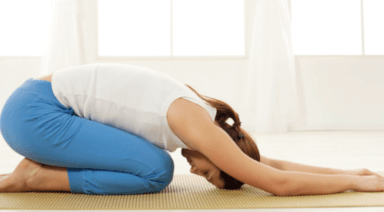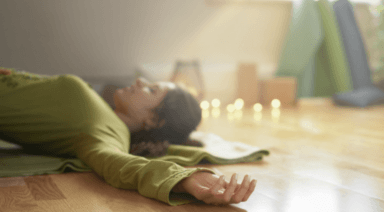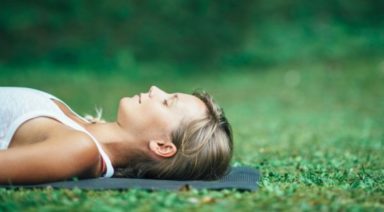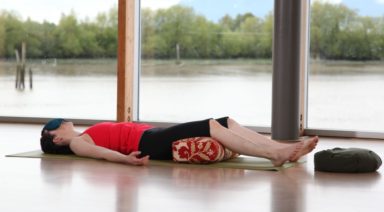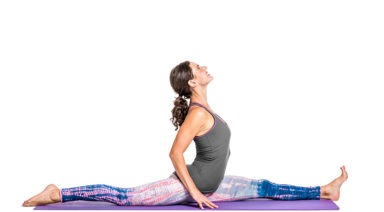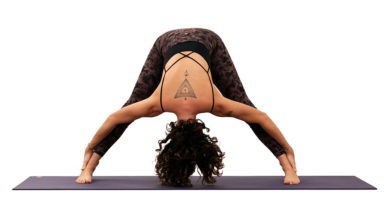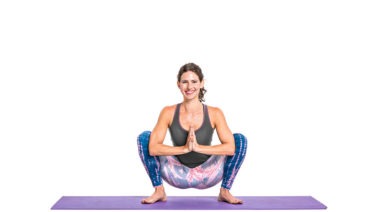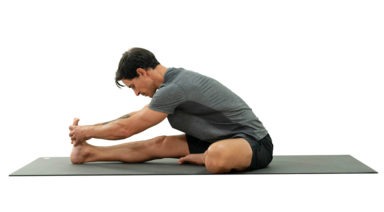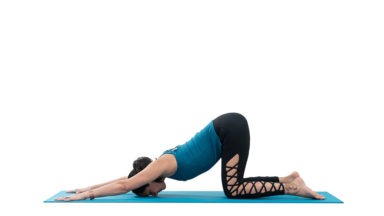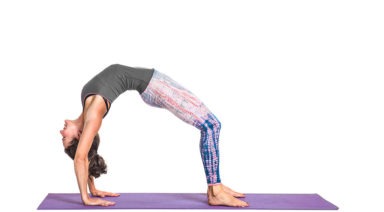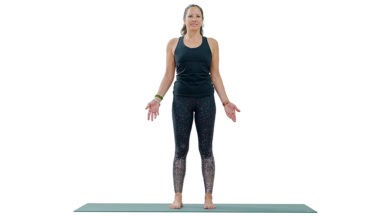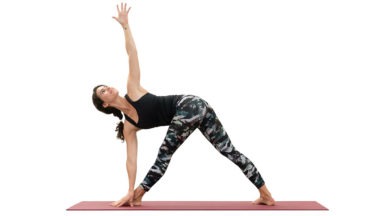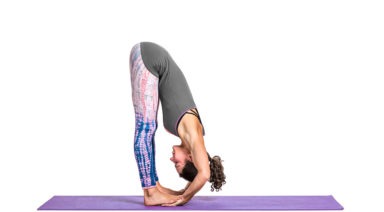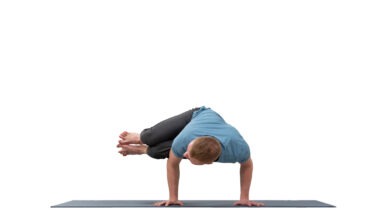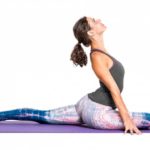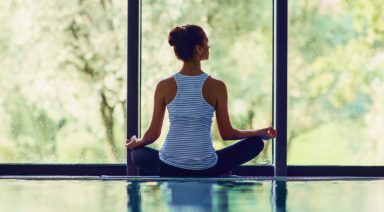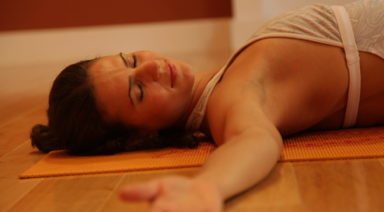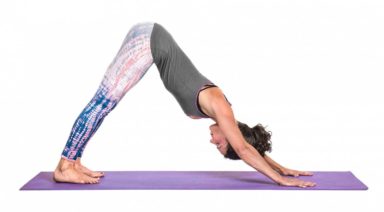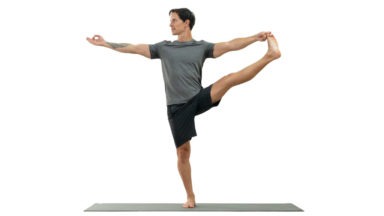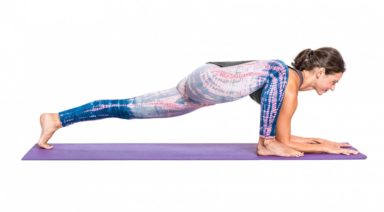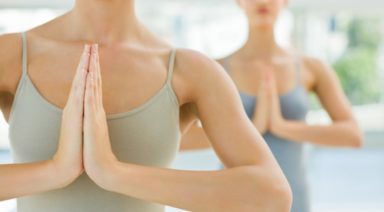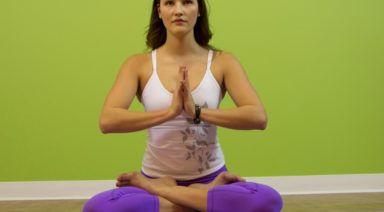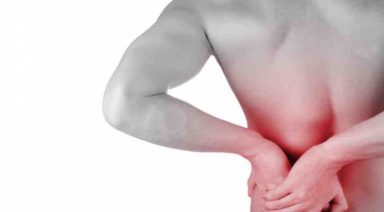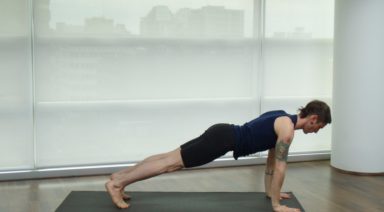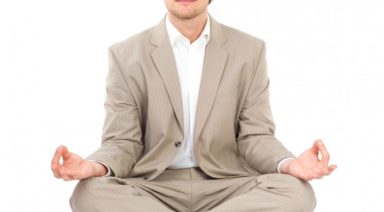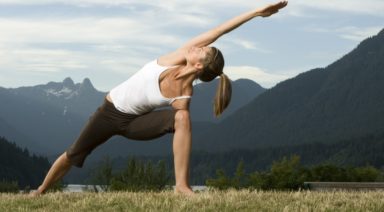Can’t sleep? 5 yoga poses to treat your insomnia

Insomnia is pure misery (there’s a reason sleep deprivation is a form of torture). Just sitting in the dark, feeling totally and completely exhausted but unable to fall asleep is like dying of thirst but unable to have a drink. However, if you’re tired of laying there night after night, there IS something you can do about your insomnia! Yoga for insomnia may be able to help you sleep better and sleep more deeply.
It should be noted that the causes of insomnia are complicated, and yoga isn’t going to be a cure-all for everyone who tries it. However, there are success stories; if you are desperate, it’s worth giving anything a try (especially something as healthy as yoga) in order to finally get a good night’s rest.
If you’re new to yoga, it might be in your best interest to try out a few classes and get some pointers before going it alone. These are definitely beginner’s poses, but making sure your body is properly aligned is the essential part of yoga, and you also don’t want to hurt yourself.
If you want to see the poses in action, click on the name of the pose!
1. Seated Forward Bend
How It Works: seeking calm and restoration? This is the pose for you. It also can help improve digestion. If digestive issues are keeping you up or waking you at night, this can help, big time.
How to Practice: Sit on the floor with your legs straight out in front of you, focusing on sitting up as straight as possible. Inhale, and raise your arms over your head, flexing your feet as you dive forward. Grab on to your feet, ankles, calves, or thighs. Don’t worry about how far you go. When you feel a gentle stretch in the backs of your legs, you’ve gone far enough to get the benefits of this pose. Keep your back as straight as you can, and stay here for 10-12 slow breaths.
2. Bridge Pose
How It Works: a back bend to help you sleep? It might not sound particularly relaxing, but it can actually help you calm down and prepare for sleep. Inversions like bridge pose alleviate stress, which is one of the major factors that can contribute to insomnia. Let’s face it, it’s your mind, not your body, keeping you up.
How to Practice: Start by lying on your back, then bend your knees, drawing your feet in, so that they’re flat on the floor right by your bottom. On your next inhale, press down with your feet and your arms to raise your bottom off of the floor. Use your inner thigh muscles to keep your legs from falling out to the sides, and clasp your hands together. Squeeze your shoulder blades together gently, and breathe in this posture for 10-15 slow breaths, then slowly release your back onto the floor.
3. Reclining Bound Angle Pose
How It Works: this is a relaxation pose that stretches your legs and reduces stress to help you sleep better and more deeply. It’s especially beneficial if racing thoughts or a restless body are keeping you awake.
How to Practice: Start in a seated position, with your feet touching each other. Lean back, so one elbow is on the floor, then lower yourself down so that your back is resting on the floor, and focus on rolling your shoulders back and pulling your shoulder blades together. Your arms should be in a neutral position, palms up, like in the photo. Close your eyes and breathe, staying in this posture for as long as you like. You can use a blanket or bolster to support your feet, like in the photo above, if necessary. You can also tuck pillows or folded blankets under your knees or thighs, if you feel like you need more support there.
4. Shoulder Stand
How It Works: a basic inversion like shoulder stand helps you slow down and relax. This posture calms the mind and relieves leg and foot soreness that might be robbing you of sleep.
How to Practice: Begin by lying on your back, then bring your knees into your chest. Place your arms flat on the floor, so that your hands extend past your bottom, palms on the floor. Push with your arms, and curl your spine to bring your legs straight up into the air. Bend your elbows, and place your hands on your lower back to support yourself in this posture. If you find shoulder stand too intense, try Legs Up the Wall instead. It’s a simpler variation with many of the same benefits.
5. Savasana
How It Works: This pose may not seem like much, but the practice of lying still and letting your body soak in the poses you just practiced helps prepare your brain for rest and relaxation.
How to Practice: Lie on your back with your feet shoulder-width apart and your arms in a neutral palms-up position by your sides. Close your eyes, and focus on your breath. Notice how your belly gently rises and falls as you inhale and exhale. There are quite a few technique that you can use while you’re in this pose. You can just focus on your breath, listen to soothing music, or choose a guided meditation to listen to.
Want more? Try our other yoga routines for sleep or these Ayurvedic tips for good sleep.
What is Restorative Yoga?
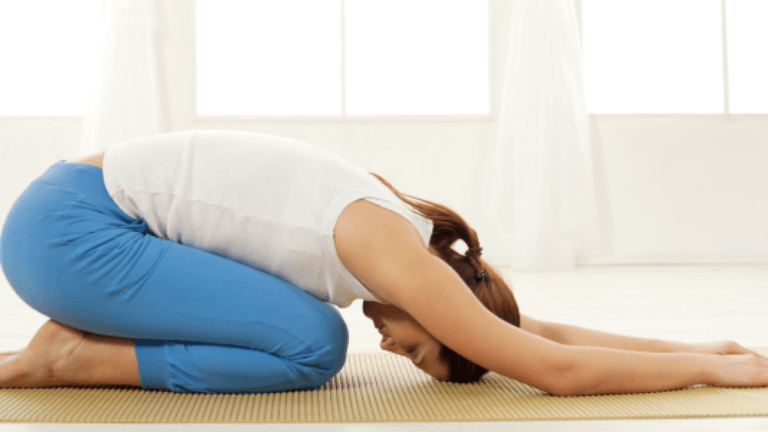
About the same time Staples office supply store debuted their “Easy Button” in 2005, I unexpectedly discovered an easy button on my yoga mat.
If you haven’t seen the Staples commercial or you missed their massive Superbowl ad campaign, let me describe it to you: In the TV commercial, a new father is trying to change his twin infant’s diapers, a child in school is stuck unable to answer a teacher’s question and a cowboy is losing control of a bucking bronco. In the midst of all these scenarios, a bright red, round “Easy” Button appears. All the user has to do is hit the button and all their problems are instantly solved. The commercial closes with the announcer saying “Wouldn’t it be nice if there was an Easy Button for your life? Well now there’s one for your business.”
You might not be wrestling a bucking bronco, but who among us hasn’t found ourselves in situations where we wish a fairy godmother or a big fat happy Easy Button would magically appear and fix all our problems?
In the start of 2005, I’d been practicing yoga for over 5 years.
In fact I’m not quite sure you could call it ‘practice’- I did yoga back then about as regularly as I watered my sad looking cactus plant.
But I was fond of trying out different yoga studios, a habit I thought of as “taking yoga field trips.”
One cold January day I sauntered into a yoga studio in Colorado Springs, prepared for a heated power yoga class. But ten minutes into the class, we were still reclined on rolled up blankets, and I was annoyed as hell that we weren’t sweating our asses off. I was expecting to be moving rapidly through postures, getting some yoga done. My obvious irritation didn’t escape the steady gaze of the instructor. As she guided us into another restorative pose her eyes met mine and she said, “For those of you who are new, you may be wondering, what is restorative yoga?”
Introducing Sammavritti
My urge to twiddle my thumbs and tap my toes began to subside as we were guided to silently count our inhales to a count of 4 or 6, and match that same silent number on the exhale. This practice is called Samavritti, the Sanskrit word that translates to mean equal fluctuations. This simple act of using my mind to connect and direct my breath created a calm sensation unlike any I’d ever experienced. Samavritti quickly became my big red “Easy Button” both on and off the mat.
Credit for developing restorative yoga poses goes to B.K.S. Iyengar, author of Light on Yoga, considered one of the yogic bibles and required reading for virtually every Yoga Teacher Training.
Iyengar creatively explored ways to utilize blankets, yoga blocks, chairs, and bolsters to aid people’s recovery from injuries and ailments.
His early days of nearly eight decades of teaching experience showed him how students overexerting in a yoga pose can cause pain or injury. His path to utilizing support and modifying the shape and length of time held in yoga poses as tools to reduce stress and restore health became the foundation of what we now call restorative yoga. He noted the tremendous benefits of restorative yoga on the thousands of students he worked with. B.K.S. Iyengar debunked the common misperception that restorative yoga is for lazy folk, saying, “Relaxation doesn’t mean yoga is a soft option. It’s a disciplined subject – a casual attempt only gains casual results.”
Benefits of Restorative Yoga
For those with more faith in science than in magic, we can look to our neurological and hormonal systems for the effects of living over stimulated and stressful lifestyles. When stress registers in the mind, it responds by giving a shout out to the adrenal glands, located above the kidneys. The adrenals react by secreting adrenaline and noradrenaline hormones. These are the hormonal weaponry and aircraft that prepare the autonomic nervous system as the body prepares for fight or flight response to stressful stimuli.
Like an overactive army, adrenal glands continue to pump stress hormones for hours after you swerved to miss the teenage texter who suddenly drifted into your lane. And they’ll continue for a long time, months after you’ve been served with divorce papers, weeks after you recover from a bad fall. The point is, as Judith Lasater Ph.D. simply states, “stress can make you sick.” Dr. Lasater’s research is often referenced in detailing the benefits of restorative yoga. Here are five ways restorative yoga can become your Easy Button:
Use Restorative Yoga to Support You in the Midst of Your Stressful Life
When we feel supported, we are more inclined to relax and release long held tension. You know that ‘Ahhh’ sound you sigh when your ass hits the sofa on Friday evening after an arduous week? Yeah, that one. Restorative yoga can give you that feeling even if it’s Tuesday.
Restorative Yoga can benefit and strengthen your spine
Well-balanced restorative sequences tend to the health of our spines through gentle movements of forward bending, back bending and twists. There is a Latin saying, “Mens sane in corpore sana” meaning: A healthy mind in a healthy body. The same is true of a healthy spine lending to a healthy mind. Anyone who’s experienced pain or spinal injury knows all too well that pain can take up residence in the mind.
Restorative Yoga can Change Your Relationship to Gravity
The majority of our waking hours are spent standing and sitting; postures which cause the accumulation of blood and lymph in our lower bodies. By elevating the legs in up the wall pose for example, inflammation is alleviated. In addition the function of the heart is enhanced in inverted restorative postures. Perhaps the yogic equivalent of flipping a U-Turn, research has shown that inverted poses adjust hormone levels, blood pressure and brain activity.
Restorative Yoga Stimulates and Soothes Your Internal Organs
Just think of it as a vacation to Fiji for your innards. The combination of forward bending mildly constricts the abdomen, and when followed by reopening the abdominals with a backbend, serves in the detoxifying movement of blood and exchange of oxygen. Gentle twists stimulate the digestive tract, tending to the absorption of nutrients on the right side, the ascending colon; aiding in the process of elimination on the left side, the descending colon, and laterally with the transverse colon.
Restorative Yoga Can Balance Your Energy
The Gravity Guru, Sir Isaac Newton, is credited with the discovery that, “what comes up, must come down”. The practices of restorative yga rest on this knowledge, balancing out the upward flow of energy, called ‘Prana’, with the downward flow of energy, called ‘Apana’. Pranic energy moves from above the diaphragm to regulate heart rate and respiration. The Apanic energy moves from below the diaphragm to direct the organs in the abdominal region. James Brown also held this yogic truth as depicted in his lyrics, “you gotta get up to get down”.
Restorative Yoga as Medicine
When I first saw the Easy Button commercial I didn’t think it related to my life at all. After all, I’m not diapering twins or performing surgery or taming wild horses. But the truth is that stress, anxiety and worry are common experiences for most of us on a daily basis. The American Institute of Stress (now there’s a bummer of a business name!) says that 3 out of 4 of all doctor’s visits are for stress-related ailments and that stress is the basic cause of up to 60% of all human ailments and disease. Stress actually shrinks the grey matter in your brain and costs our society over $300 billion every year in health costs and loss of productivity.
Every individual experiences it differently, but for yoga practitioners the beneficial practices of restorative yoga can be serious medicine in the fight against stress and worry.
So next time your boss decides to cancel your vacation or your toddler flushes the Legos or your teenager swipes your credit card and heads to the mall, hit the Easy Button and give your body and mind a break. You will be roping those wild horses again in no time.



